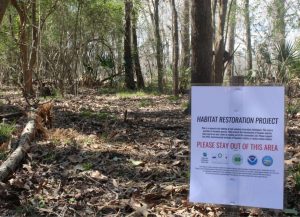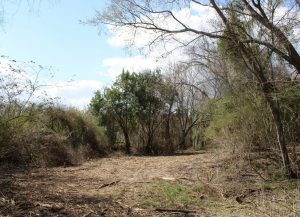
Environmental Justice Association puts down roots on Pocket Prairie
The Environmental Justice Association (EJA) announced their “Pocket Prairie” environmental restoration project at the Feb. 15 SGA meeting to restore the native surrounding landscape and make the campus more visible by replacing the non-native trees and grass.

This project runs parallel to the renovations made by UHCL and the Environmental Institute of Houston (EIH) at each of the 3 campus entrances starting with Entrance 2.
EJA is currently tasked with seeding the area behind the STEM building in front of Entrance 2, which involves sowing the land and planting seeds to grow.
The original plan UHCL proposed involved planting lawn grass and installing an irrigation system that would be costly to maintain. “I don’t want to do what we have done at Entrance 1… from a financial aspect lawn grass has to be mowed every week, it needs an irrigation system put in to keep it watered in the summer months and it’s an incredibly expensive endeavor to maintain,” said Mark Denney, vice president for Administration and Finance. The EIH approached the school after staff members noticed the cutting of trees and removing the thicket and proposed a more natural alternative.
The efforts begin with the removal of vegetative invasive species from the entrances to the campus. The removal of trees and thickets allows newly planted native species of trees and grasses to grow.
The reintroduction of native grass and vegetation is expected to reduce the cost of maintenance. The native grass grows more slowly and only needs mowing once a year. “ If we’re successful and have more of a natural habitat along the Bay Area Boulevard it will … significantly lower cost to maintain,” said Denney.
The seeding and growing will take 3 years; the EJA wishes to expand and continue in the future. “This project will hopefully be ongoing, hopefully for the next decade,” said Jeffrey Fato, president of EJA. “We really want to look at Entrance 2 as our phase one so that we hopefully bring more of this prairie ecosystem further onto campus.”
UHCL currently sits on a 524-acre wildlife preserve and used to be a coastal prairie. Less than 1% of the Gulf Coast Prairie originally in Texas remains. The EJA and the EIH seek to restore three acres of Coastal Prairie land on campus.
“[Coastal prairie is] what we are trying to put over at Entrance 2 to bring back some of these native species that would have been here,” said Wendy Reistle, environmental education program coordinator for EIH.
The efforts also include removing the trash that gets thrown out in the area.” There were 77 tires we pulled out of there, there is a lot of trash,” said Reistle.
Rowena McDermid, graduate environmental science major, selected the seeds. McDermid included up to 40 different species of plants that EJA’s 20 active members will seed.
“We went out and harvested local prairies because we want to have it local native, not just Texas native,” said Reistle.
The first seeding of the Prairie Project will take place March 12 behind the STEM building by
Entrance 2. Volunteers to help EJA with seeding are welcome to attend.

“By restoring this environment, we want to be able to open this up to be a living laboratory,” said Fato “We want this to be an asset to be used by everyone on this campus.”
Denney approved the project Oct. 11, 2021.
“This is still a goal of ours to open up our campus, make it more accessible but remain true to our commitments that this is a natural preserve and we want to preserve these natural landscapes that this campus has,” said Denney.
The EIH and the EJA are looking for volunteers to help out with the project and get involved. EJA meets every Tuesday from 9-11 a.m. at the North Office Annex and Friday at the Nature Trail from 1-3 p.m. to continue its efforts in planting this Pocket Prairie. You do not need to be an EJA member to volunteer.
